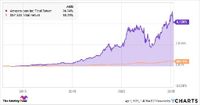Amazon.com Inc. (NASDAQ: AMZN) has faced significant stock price declines recently, reflecting broader trends in the tech industry and investor caution. On April 4, 2025, Amazon's stock dropped by 4.15%, closing at $171.00. This decline was part of a larger sell-off in tech stocks, which saw the Nasdaq Composite index fall over 5.6% on the same day. The stock had opened at $167.14 and reached an intraday high of $178.14 before closing sharply lower.
Pre-market data on April 7 showed further troubles for Amazon, with another 4.23% decline, bringing the stock down to $163.77. This drop has raised concerns about valuation fatigue and moderation in e-commerce spending. Analysts noted that Amazon's price-to-earnings (P/E) ratio is nearing 61, leading to warnings that the stock may be overpriced in the short term. Any signs of weakness in upcoming earnings could trigger even sharper sell-offs.
Market analysts are closely monitoring the situation. Brian Nowak from Morgan Stanley remarked, "Amazon remains a long-term leader, but short-term growth fatigue is visible in investor reaction." John Blackledge from Cowen added, "The recent AI hype rally may have run ahead of fundamentals. Investors are pulling back to reassess Q1 results." These comments highlight the cautious sentiment surrounding Amazon and the tech sector as a whole.
In addition to the immediate pressures on Amazon's stock, there are longer-term concerns about its core business. Slowing retail demand and macroeconomic tightening are raising red flags about the company's resilience. Rising inventory costs and operational expenses are also squeezing profit margins, adding to the challenges faced by the e-commerce giant.
Technical analysis of Amazon's stock indicates immediate support levels between $162 and $165, with the next major support level at $152, which is near its 52-week low of $151.61. Resistance is seen at the $178 to $180 range. The pre-market dip on April 7 suggests that a test of critical support near $160 is likely in the next trading session.
Looking ahead, the short-term risks for Amazon include potential Q1 earnings disappointments, soft consumer sentiment due to inflation, and a slowdown in cloud and AWS revenue. However, there are also long-term positives to consider. The integration of artificial intelligence into the AWS ecosystem and strong growth in advertising could position Amazon favorably in the long run. Some long-term investors might view this decline as a strategic entry point, while short-term traders are advised to wait for stabilization near key technical support.
Adding to the market's woes, tariffs imposed by the government have further rattled investor confidence. On a Thursday in early April, the introduction of profit-sapping importation fees led to the S&P 500 closing almost 5% lower, with Amazon's stock suffering a particularly hard hit, closing down 9%. This decline has erased over 30% of Amazon's gains for 2024, pushing its share price back to where it was a year ago.
Historically, Amazon has experienced dramatic price drops, often followed by recoveries. For instance, the stock dropped 8.8% on August 2, 2024, after disappointing earnings and fell 22% at the onset of COVID-19 lockdowns. Despite these fluctuations, Amazon has a proven ability to rebound, with long-term investors seeing substantial returns over time. If someone had invested $10,000 in Amazon on New Year's Day 2007 and never sold, they would have approximately $388,000 today.
Analysts from Jefferies have pointed out that the current tariffs could allow companies like Amazon to reset their financial guidance to more conservative figures. They noted that lower estimates tend to improve investor sentiment, which can ultimately lead to better share performance. However, the analysts also cut their forecasts for Amazon's earnings per share by 1% for 2025, reflecting the ongoing uncertainty in the market.
As the market reacts to these tariffs and macroeconomic uncertainties, businesses across various sectors, including Target and Best Buy, have announced plans to raise prices in response to increased import duties. This has contributed to a broader market sell-off, with U.S. stocks experiencing their worst single-day losses since 2020. At market close on a recent Friday, the S&P 500 was down 6%, the Dow was down 5.5%, and the Nasdaq composite dropped 5.8%.
In light of these developments, investors are left wondering what the future holds for Amazon and the tech sector. The upcoming earnings season will be crucial in determining whether Amazon can stabilize its stock price or if it will continue to slide further into bearish territory. With the market's volatility and the ongoing economic pressures, investors are advised to proceed with caution while keeping an eye on potential recovery opportunities.
In summary, Amazon's stock price has faced significant declines amid broader market challenges and concerns about its core business performance. With macroeconomic pressures, tariff implications, and earnings season approaching, the next few weeks will be critical for Amazon as it navigates these turbulent waters.






